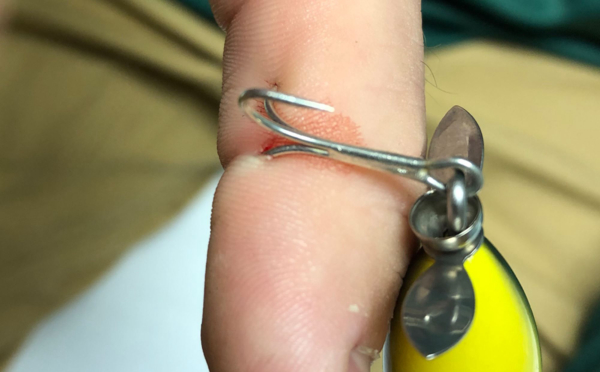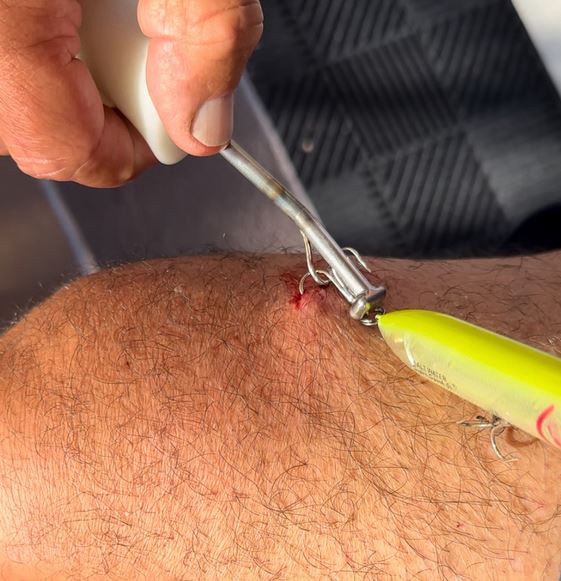
If you’ve fished much, you’ve been hooked a time or two.
Not as in fascinated or addicted, but as in actually stuck like the fish you hope to catch.
I’ve had hooks in most parts of my anatomy over a long career on the water. When I was guiding at Homosassa, a customer reared back and buried 3 sets of trebles in the top of my head while trying to make a mighty cast towards a rolling tarpon. That one required several shots of Novocain and several more of tequila, and also shaving half my head, but no permanent harm done.
Under a bridge in Sarasota, a pal trying to heave a pinfish to whopper snook basking in the lights put a 5/0 in the joint of my left thumb. Yikes!!
And of course I’ve hooked myself through carelessness more times than I can count.

I’ve been much more fortunate, though, than a charter customer of Florida Captain Phil Chapman, who while wielding a 12-weight flyrod for tarpon, had his streamer get out of control, somehow snake between his legs and bury itself in his most sensitive region. Which, it turned out, is also an area richly supplied with blood vessels. The angler’s shorts, leg and the boat deck quickly made it clear what happened. That one was a long trip to the emergency room, per Captain Phil.
Small hooks are not hard to remove—fly fishermen regularly take the gnat-sized fly hooks out of their hands and neck with a pair of forceps they also use for dehooking trout. Most of us can stand to pull anything up to about a size 1 out with pliers. Big hooks, on the other hand, are more contrary due to the large barbs, and they really get your attention.
The classic hook removal tactic, pushing the point on through and clipping off the barb, hurts like heck with big hooks—it’s like getting a shot but with a roofing nail. Not many people can stand it without Novocain.
The improved tactic now used by most experienced anglers is to use a piece of strong fishing line to extract the hook. The procedure is:

This procedure usually works, but if you don’t happen to have some stout line aboard or if you haven’t practiced the tactic a bit, it can be iffy. And of course it really hurts if it doesn’t work the first time.
Enter the DHUKR, which is a tool made specifically for hook extraction from humans or pets (though it could work on fish, too.)
A stainless steel arm with a V fitting to stabilize the hook shank and an arm that goes around the hook bend is set into a stout composite handle. You fit the device over the hook, and much in the same mechanics as with the line-pull tactic, snatch the hook out in a single movement.
Because of the much better grip, the solid connection and the control of the shank angle, the device is more dependable than using fishing line for the extraction.
The company was so confident in the product that they were offering to hook anyone with the nerve to try it at ICAST, and then snatching the hook out. There were several takers who reported that it was (relatively) painless, at least with typical inshore-sized jig hooks.
The thing is pretty pricey at $59.99, but it might be considered cheap insurance against the day you really need it. Seems like it should be standard issue for fishing guides, party boats, pier operators, emergency rooms, and maybe vet clinics—dogs have a way of finding fish hooks with some frequency, in my experience.
Learn more and see a video here: https://dhukrtool.com/product/dhukr-device.
— Frank Sargeant